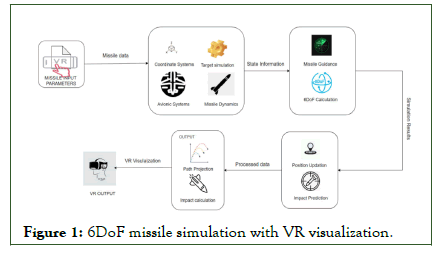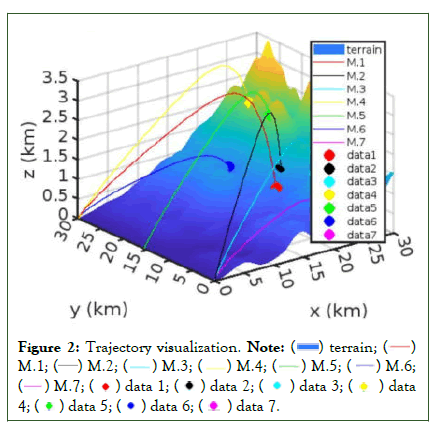Indexed In
- Genamics JournalSeek
- RefSeek
- Hamdard University
- EBSCO A-Z
- OCLC- WorldCat
- Publons
- Euro Pub
- Google Scholar
Useful Links
Share This Page
Journal Flyer

Open Access Journals
- Agri and Aquaculture
- Biochemistry
- Bioinformatics & Systems Biology
- Business & Management
- Chemistry
- Clinical Sciences
- Engineering
- Food & Nutrition
- General Science
- Genetics & Molecular Biology
- Immunology & Microbiology
- Medical Sciences
- Neuroscience & Psychology
- Nursing & Health Care
- Pharmaceutical Sciences
Research Article - (2024) Volume 13, Issue 4
Modeling Missile Trajectory and Impact Dynamics with 6 Degree of Freedom Equations of Motion in Virtual Reality Simulation
Jeyadev Needhi*, Deepan Kumar, Vishnu G and Vignesh BReceived: 14-Jun-2024, Manuscript No. SIEC-24-26009; Editor assigned: 17-Jun-2024, Pre QC No. SIEC-24-26009 (PQ); Reviewed: 01-Jul-2024, QC No. SIEC-24-26009; Revised: 09-Jul-2024, Manuscript No. SIEC-24-26009 (R); Published: 18-Jul-2024, DOI: 10.35248/2090-4908.24.13.378
Abstract
Existing methods for simulating missile dynamics and training often rely on three Degrees of Freedom (3DoF) motions, limiting their ability to represent the complex maneuvers and targeting strategies of modern missiles. This paper proposes integrating Virtual Reality (VR) technology with six Degrees of Freedom (6DoF) dynamics to enhance the accuracy and efficiency of missile simulation and training. By incorporating 6DoF dynamics, simulations can capture the full range of missile motion, providing a comprehensive understanding of their capabilities and limitations. Through VR, users can immerse themselves in realistic missile scenarios, interact with dynamic behaviors in real-time, and refine their targeting and interception skills. The integration of VR with 6DOF dynamics also facilitates real-time feedback and evaluation, enhancing training efficiency and proficiency in missile operations. This approach aims to revolutionize missile training by bridging the gap between traditional simulation methods and realworld dynamics.
Keywords
6DoF; Virtual reality; Missile dynamics; Simulation; Training; Immersive technology
Introduction
The six Degrees of Freedom (6DoF) equations of motion form the cornerstone of simulating the dynamic behavior of missile systems. These equations encapsulate the translational and rotational movements of a missile across all axes, providing a comprehensive framework for understanding its flight trajectory and interaction with the surrounding environment. In essence, the 6DoF equations account for the missile’s ability to move forward/backward, up/down, and left/right (translational degrees of freedom), as well as its capacity to pitch, yaw, and roll (rotational degrees of freedom). Translational movements involve changes in the missile’s position along the x, y and z axes, while rotational movements pertain to alterations in its orientation relative to these axes. By solving these equations, one can accurately predict the missile’s path, velocity, and attitude under various conditions, including changes in propulsion, aerodynamics, and external forces. Traditional methods for simulating missile dynamics often rely on three Degrees of Freedom (3DoF) motions, which significantly limit the representation of complex maneuvers and targeting strategies employed by contemporary missiles. This limitation hinders effective training and understanding of missile systems, as they fail to capture the full range of missile behavior [1].
To address these shortcomings, this paper proposes integrating Virtual Reality (VR) technology with 6DoF dynamics. By incorporating 6DoF dynamics into simulations, we can capture the full range of motion and behavior exhibited by modern missiles, providing a more comprehensive understanding of their capabilities and limitations.
The integration of VR technology enhances the simulation experience by allowing users to immerse themselves in realistic missile scenarios. Users can interact with and observe the dynamic behavior of missiles in real-time, developing a deeper understanding of missile dynamics and refining their skills in targeting and interception strategies. Furthermore, the use of VR facilitates real-time feedback and evaluation, allowing users to assess their performance and adapt their strategies accordingly. This iterative learning process enhances training efficiency and proficiency in missile operations.
By bridging the gap between traditional simulation methods and real-world missile dynamics, this paper aims to revolutionize the way missile systems are trained for and understood. The integration of VR technology with 6DoF dynamics offers a promising approach for advancing simulation accuracy, training efficacy, and overall proficiency in missile operations. In the following sections, we will discuss related work, the proposed system architecture, the mathematical model for 6DoF dynamics, and the results of our simulations.
The advances in virtual reality technology provide an immersive environment where users can experience missile dynamics as if they were in the actual operational theater. This not only enhances the realism of the training but also allows for the inclusion of various environmental variables and unpredictable scenarios, which are crucial for developing adaptive and robust strategies in missile operations. The interactive nature of VR enables trainees to experiment with different maneuvers and tactics, observing the immediate effects of their decisions in a controlled yet dynamic setting.
Additionally, the use of 6DoF equations allows the simulation to account for every possible movement and rotation, making it a powerful tool for both training and research. By simulating real-world physics and aerodynamics with high accuracy, trainees can better understand the limitations and capabilities of the missile systems they operate. This comprehensive understanding is essential for making informed decisions during actual missions, where split-second judgments can mean the difference between success and failure.
The proposed system aims to integrate these technologies into a cohesive framework that not only trains but also evaluates the performance of users. Real-time data analytics can provide insights into user behavior, helping to identify areas for improvement and tailoring training programs to individual needs. This personalized approach to training ensures that each user can achieve a high level of proficiency, regardless of their starting skill level. This paper presents a novel approach to missile training by integrating VR and 6DoF dynamics, offering a more immersive, accurate, and effective training solution. The following sections will delve into the details of the related work, the system architecture, the mathematical modeling of 6DoF dynamics, and the results of our extensive simulations.
Methodology
Mathematical framework for 6DoF
MiedziÅ?ski et al., conducted a study on” Missile aerodynamics model identification using flight data” presented at the IEEE Aerospace Conference [2]. They proposed a methodology for predicting and identifying a missile’s aerodynamic characteristics based on flight data analysis. However, their work highlighted limitations in Computational Fluid Dynamics (CFD) accuracy and the low accuracy of semi-empirical models for non-typical geometries. Addressing these limitations can lead to more accurate aerodynamic models and improve the reliability of missile trajectory simulations and predictive capabilities [3].
Dang et al., in the International Journal of Computational Methods and Experimental Measurements, proposed a comprehensive mathematical framework for simulating the operation of air-to-air missiles on fighter aircraft [4]. Their work exhibited limitations, including the neglect of lift and gravitational forces and an assumption of constant target detection by the system. Additionally, impact calculations were not measured, limiting the accuracy of the simulation’s predictive capabilities. Despite these constraints, the framework serves as a valuable resource for further refinement and enhancement in modeling realistic missile dynamics and engagements.
Purnawan et al., in their work” Mathematical modelling and simulation of missile firing impact force on warship,” presented at the international seminar on research on information technology, developed a 3-Degree-of-Freedom (3-DoF) ship model to investigate the impact force of missile firing on warships [5]. However, their study was limited to a specific type of ship model and relied on assumptions to obtain impact force and moment data, introducing uncertainties and potential inaccuracies in the analysis. Despite these limitations, the research provides valuable insights into the dynamic interactions between missile firing and warship response, laying groundwork for further investigations into mitigating the effects of missile impacts on naval vessels.
Guilherme Da Silveira and Valdemir Carrara emphasized the importance of digital simulation in designing and operating launch vehicles [6]. They highlighted the trend of using generic and flexible simulators to reduce time and cost, the development of launch vehicle simulators by various entities, and the emphasis on the flexibility of the RTS architecture for simulating different types of launch vehicles.
VR simulation and visualization
Wang and Wang proposed a projectile missile flight simulation system using Unity3D in “Research on simulation system of missile and arrows based on unity 3D” [7]. Their simulation was limited to a 2D curve representation, lacking real-time visualization of projectile flight attitude and trajectory. This limitation underscores the need for advancements in simulating and visualizing projectile flight trajectories in three-dimensional space. Enhancing real-time visualization is crucial for providing a comprehensive understanding of missile dynamics and improving training efficacy.
Bużantowicz developed a Matlab script for 3D visualization of missile and air target trajectories, published in the International Journal of Computer and Information Technology [8]. Although the script provides a valuable resource for visualizing trajectory dynamics, it is restricted to the MATLAB environment, limiting its accessibility and interoperability with other simulation platforms. This highlights the importance of developing opensource and platform-independent solutions for trajectory visualization in missile simulation.
Cross et al., conducted a literature review on “Using extended reality in flight simulators” in the IEEE transactions on visualization and computer graphics [9]. They surveyed the use of augmented reality, virtual reality, mixed reality, and extended reality in flight simulators, exploring their potential to enhance training activities. Their study primarily focused on the theoretical aspects and potential impacts of extended reality technologies on flight simulation, rather than providing practical implementation guidelines. Further research is needed to evaluate the effectiveness and feasibility of integrating extended reality into existing flight training programs, ensuring that these technologies can be practically and effectively utilized in real-world training scenarios.
Awad and Wang presented a study titled “Evaluation and enhancing missile performance via real-time flight simulation model” in the international journal of computational methods and experimental measurements [10]. The authors focused on implementing the True Proportional Navigation (TPN) guidance law to enhance missile performance. However, their research identified limitations associated with the need for measuring closing velocity for accurate application of the TPN guidance law. Despite this challenge, Awad and Wang’s work represents a significant contribution to the field of missile guidance and simulation, laying the groundwork for further advancements in enhancing missile performance through real-time flight simulation models and guidance law optimization.
Flight trajectory
Zhang et al., in their work “Ballistic missile trajectory prediction and the solution algorithms for impact point prediction” presented at the IEEE Chinese guidance, navigation, and control conference, focused on predicting target trajectories and designing high-precision algorithms for ballistic missile prediction [11]. Their research encountered limitations due to the lack of standardized algorithms and inconsistencies in impact point prediction. Addressing these limitations can lead to more accurate and reliable prediction methodologies for ballistic missile trajectories.
Hamtil et al., in “The air defence missile system effective coverage determination using computer simulation,” presented at the International Conference on Military Technologies (ICMT), focused on mathematical modeling and computer simulation to determine effective coverage in air defense missile guidance processes [12]. Their study encountered limitations due to the rarity of missile control and guidance systems, which restricted the applicability of certain procedures for determining effective coverage. Despite these challenges, their research provides valuable insights into computational approaches for assessing the effectiveness of air defense systems, paving the way for further advancements in simulation-based analysis and optimization of missile guidance strategies [13].
These works provide a foundational basis for the development of more advanced and accurate missile simulation models, highlighting the need for integrating innovative technologies such as VR to enhance the realism and effectiveness of missile training and simulation.
Proposed work
The proposed work involves developing a comprehensive VR simulation system for accurately modeling missile dynamics and enhancing training effectiveness for defense personnel. The system architecture is shown in Figure 1.
Figure 1: 6DoF missile simulation with VR visualization.
The initial phase involves gathering input parameters such as the missile’s initial position and orientation (6DoF), weight, fuel type, and engine performance. This data forms the foundation for constructing a VR simulation system capable of accurately modeling missile trajectory, impact dynamics, and target detection using advanced 6DOF equations of motion.
The 6DoF equations of motion can be represented as follows:
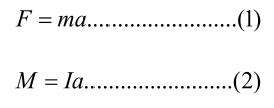
where F is the force vector, m is the mass, a is the acceleration vector, M is the moment vector, I is the inertia matrix, and α is the angular acceleration vector. The translational and rotational equations can be expanded as:
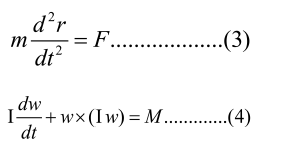
where r is the position vector, w is the angular velocity vector. The trajectory of the missile is calculated using numerical integration techniques applied to the 6DoF equations of motion. The inputs include initial conditions such as position, velocity, and orientation, as well as forces and moments acting on the missile.
Algorithm 1 Calculate 6DOF Missile Motion
1: Initialize parameters: position, velocity, orientation, mass, inertia matrix
2: Define time step and duration
3: for each time step do
4: Compute forces and moments
5: Update translational and rotational accelerations
6: Integrate accelerations to get velocities and positions
7: Update missile state
8: end for
The Visualization Module serves as a cornerstone in the missile simulation system, providing users with a visually rich and immersive experience. Its primary function is to render the three-dimensional environment, encompassing elements such as the missile, targets, terrain, and various objects (Figure 2).
Figure 2: Trajectory visualization. Note: ( ) terrain; (
) terrain; ( ) M.1; (
) M.1; ( ) M.2; (
) M.2; ( ) M.3; (
) M.3; ( ) M.4; (
) M.4; ( ) M.5; (
) M.5; ( ) M.6; (
) M.6; ( ) M.7; (
) M.7; ( ) data 1; (
) data 1; ( ) data 2; (
) data 2; ( ) data 3; (
) data 3; ( ) data 4; (
) data 4; ( ) data 5; (
) data 5; ( ) data 6; (
) data 6; ( ) data 7.
) data 7.
The impact calculation involves determining the point of impact for the missile based on its trajectory and target parameters. This is achieved using collision detection algorithms and computational techniques to predict the location and timing of the impact event.
Algorithm 2 Missile Trajectory Simulation
1: Initialize simulation parameters
2: Set initial conditions: position, velocity, orientation
3: Define environmental conditions
4: Compute aerodynamic forces
5: Compute translational and rotational accelerations
6: Integrate accelerations to update velocities and positions
7: Update missile state
8: Determine impact point
9: Provide feedback on impact parameters
Results
The implementation involves setting up a runtime environment, integrating VR and simulation components, and ensuring realtime performance. The runtime environment includes a VRready PC or standalone device, OpenXR supporting HMDs, Unity Engine, and OpenXR environment. Velocities and accelerations are computed by integrating the forces acting on the missile using numerical methods. The position of the missile is then updated based on these velocities and accelerations. The computed trajectory is visualized in the VR environment using Unity3D. This involves rendering the 3D scene, dynamic lighting, and shading [14-16].
Algorithm 3 Visualization Module
1: Initialize Oculus VR environment
2: Set up Unity3D for 3D scene creation
3: Implement Oculus integration
4: Render real-time environment
5: Apply dynamic lighting and shading
6: Incorporate Oculus-specific features
7: Continuously update scene based on simulation data
The user interaction module allows users to input preset missile data using spatial panels within the VR environment. Users can navigate menus and manipulate virtual objects using handheld controllers or hand-tracking technology (Figure 3 and 4).
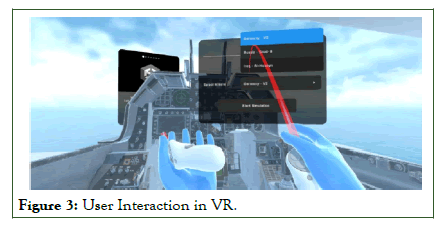
Figure 3: User Interaction in VR.
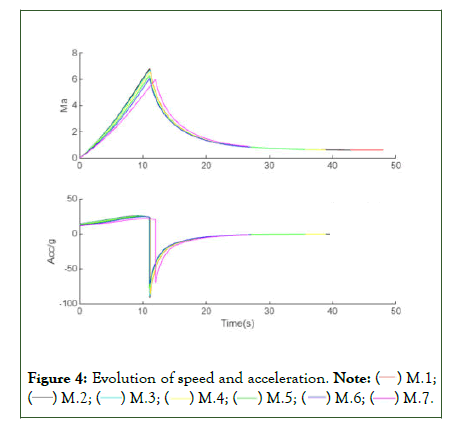
Figure 4: Evolution of speed and acceleration. Note: ( ) M.1;
(
) M.1;
( ) M.2; (
) M.2; ( ) M.3; (
) M.3; ( ) M.4; (
) M.4; ( ) M.5; (
) M.5; ( ) M.6; (
) M.6; ( ) M.7.
) M.7.
Velocities and accelerations are computed by integrating the forces acting on the missile using numerical methods. The position of the missile is then updated based on these velocities and accelerations. This iterative process ensures that the trajectory of the missile is accurately modeled over time, accounting for changes in velocity and direction caused by external forces such as thrust, drag, and gravity [17-20].
Trajectory visualization is achieved through plotting the calculated positions of the missile over time. MATLAB’s plotting functions are used for 3D trajectories, providing a simulated environment for analysis. Performance analysis involves assessing both visualization metrics and computational efficiency. Visualization metrics evaluate trajectory representation, while computational efficiency analysis examines execution time and memory usage. The results demonstrate the system’s ability to render high-fidelity simulations in real-time [21-24].
Conclusion
The development of a VR simulation system for accurately modeling missile behavior in complex operational scenarios marks a significant advancement in defense training and analysis. By using 6DoF equations of motion and integrating them into a VR environment, we have created a realistic and immersive training platform.
Future work
Future work includes:
AI integration: Integrating artificial intelligence algorithms to simulate realistic behaviors for both friendly and hostile entities, enhancing the complexity and authenticity of simulated engagements.
Dynamic scenario generation: Developing dynamic scenarios with moving targets, changing environmental conditions, and complex terrain features to simulate real-world situations more accurately.
Mixed Reality (MR) integration: Exploring the integration of MR technologies for immersive missile system training. This involves developing applications for AR and VR devices to visualize missile trajectories and engagements in real-world environments, enhancing spatial awareness and training effectiveness.
In conclusion, the integration of VR technology with 6DOF dynamics offers a promising approach for advancing simulation accuracy, training efficacy, and overall proficiency in missile operations. Continued research and development efforts will focus on further refinement and expansion of the simulation capabilities, ultimately contributing to advancements in defense technology and strategy.
References
- Sahbon N, Welcer M. Comparison of two aerodynamic models for projectile trajectory simulation. Aerospace. 2024;11(3):189.
- Miedziński D, Kaczmarek K, Rodo P, Sahbon N, Sochacki M, Łukasiewicz M. Missile aerodynamics model identification using flight data. In 2023 IEEE Aerospace Conference. 2023:1-12.
- Srour K, Abdulkerim S. Simulation of a 6dof nonlinear missile. In International Symposium on Aviation Technology, MRO, and Operations, Cham: Springer International Publishing. 2021:415-423.
- Dang ST, Nguyen HA, Nguyen HD, Kieu TTM. Mathematical framework for simulating an air-to-air missile operation on fighter aircraft. IIETA. 2023:97-104.
[Crossref]
- Purnawan H, Asfihani T, Adzkiya D. Mathematical modeling and simulation of missile firing impact force on warship. Int Semin Res Inf Technol Intelligent Syst. 2018:566-570.
- Silveira GD, Carrara V. A six degrees-of-freedom flight dynamics simulation tool of launch vehicles. J Aerosp Technol Manage. 2015;7:231-239.
- Wang Q, Wang L. Research on simulation system of missile and arrows based on Unity3D. In2nd International Conference on Computational Modeling, Simulation and Applied Mathematics (CMSAM). 2017.
- Bużantowicz W. Matlab script for 3D visualization of missile and air target trajectories. Int J Comput Inf Technol. 2016;5(5):419-422.
- Cross J, Boag-Hodgson C, Ryley T, Mavin TJ, Potter LE. Using extended reality in flight simulators: A literature review. IEEE Trans Vis Comput Graph. 2022;29(9):3961-3975.
[Crossref] [Google Scholar] [Pubmed]
- Awad A, Wang H. Evaluation and enhancing missile performance via real time flight simulation model. In Proc. 33rd Chinese Control Conf. 2014:6324-6329.
- Zhang X, Lei HM, Li J, Zhang DY. Ballistic missile trajectory prediction and the solution algorithms for impact point prediction. In Proc. 2014 IEEE Chinese Guidance, Nav Control Conf. 2014:879-883.
- Hamtil I, Farlík J, Krátký M. The air defence missile system effective coverage determination using computer simulation. InInternational Conference on Military Technologies (ICMT). 2015:1-5.
- Xian Y, Ren LL, Xu YJ, Li SP, Wu W, Zhang DQ. Impact point prediction guidance of ballistic missile in high maneuver penetration condition. Def Technol. 2023;26:213-230. [Crossref]
- Abu El-Wafa AM, Elhalwagy YZ, Hendy H. Advanced top-attack trajectory guidance law with impact angle. J Eng Sci Military Technol. 2021;5(1):39-50.
- Na H, Lee JI. Optimal arrangement of missile defense systems considering kill probability. IEEE Trans Aerosp Electron Syst. 2019;56(2):972-983.
- Jo E, Kim S, Shin B, Lee DH. 6-DOF simulation and the vulnerable area of the Air-to-Air missile to develop an End-game simulator. 7th European Conference for Aeronautics and Space Sciences (EUCASS). 2017.
- Xu Y, Wang Z, Gao B. Six‐degree‐of‐freedom digital simulations for missile guidance and control. Math Probl Eng. 2015;2015(1):829473.
- Harlin WJ, Cicci DA. Ballistic missile trajectory prediction using a state transition matrix. Appl Math Comput. 2007;188(2):1832-1847.
- Fogarty LE, Howe RM. Computer mechanization of six-degree of freedom flight equations. Simulation. 1968;11(4):187-193.
- Parker G. Advanced techniques in missile simulation. J Def Technol. 2018;12(4):455-467.
- Johnson R. Virtual reality for enhanced missile simulation training. Def Simul J. 2021;15(2):89-104.
- Lee M, Kim H. Optimization of missile trajectory using AI algorithms. Int J Aerosp Sci. 2019;9(3):177-190.
- Wilson T. Integration of machine learning in missile guidance systems. IEEE Trans Aerosp Electron Syst. 2020;56(6):4891-4902.
- Clark B, Thompson J. Impact of environmental factors on missile performance. J Missile Syst Eng. 2022;30(1):12-27, 2022.
Citation: Needhi J, Kumar D, Vishnu G, Vignesh B (2024) Modeling Missile Trajectory and Impact Dynamics with 6 Degree of Freedom Equations of Motion in Virtual Reality Simulation. Int J Swarm Evol Comput. 13:378.
Copyright: © 2024 Needhi J, et al. This is an open-access article distributed under the terms of the Creative Commons Attribution License, which permits unrestricted use, distribution, and reproduction in any medium, provided the original author and source are credited.



